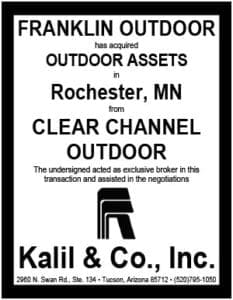From the OAAA Outlook Newsletter
A gathering of nearly 2,700 brand marketers came together last week in Orlando, FL, for the annual Association of National Advertisers (ANA) Masters of Marketing Conference: Growth. Among the attendees, over 1,700 were ANA members who represented advertisers ranging from Fortune 500 companies to smaller regional brands.

1. Brand and creative excellence
2. Talent
3. Marketing organization management
4. Measurement, data/analytics, and accountability
5. Brand purpose
6. Gender equality
7. Inclusiveness, diversity, and multicultural marketing
8. Streamlining the digital media supply chain
9. Transparency
10. Brand safety and ad fraud
11. Advocacy and self-regulation
12. The future of advertising, marketing, and growth
Other main-stage speakers echoed the concerns raised by Liodice, including Procter & Gamble’s global head of marketing, Marc Pritchard, who has been signaling concerns related to digital media for a long time. One solution embraced by P&G has been the deliberate reduction in the number of websites where the company’s ads are viewed. P&G brands now appear on only 200 trusted platforms. The company has stopped buying ad space on “cheaper long tail websites.”
JPMorgan Chase Chief Marketing Officer Kristin Lemkau estimated, “the loss in ad spend last year due to digital ad fraud was $7.2 billion and would climb to $16.4 billion this year.”
Like P&G, her company has reduced the number of websites where ads are placed, from 400,000 to 5,000 platforms that have been designated as trustworthy.
In addition to digital media, another key theme of the conference was the importance of purposeful marketing and advertising for good (touching hearts and opening minds, promoting something that matters, or taking a stand). These were topics discussed by many of the conference presenters, noting how today’s consumers demand authenticity in the way brands present value, especially Millennials.
Brian Beitler, head of marketing for Lane Bryant, discussed how the heritage of a brand can define the brand purpose. At his company, the heritage defines the culture, brand value, and how customers are treated. In his example, the company’s marketing objective was to redefine sexy, proving beauty comes in all shapes and sizes. The campaign launched with a single OOH execution, a wrapped subway train on New York’s F line. The campaign drove 13.1 million social impressions, and the OOH campaign was expanded during Fashion Week with executions appearing across Manhattan.
Beitler explained, “the challenge remains, doing beautiful ads while still getting the brand into the ad so people know who made the ad.”
One of the high points at the conference was a presentation by Chicago Cubs President Crane Kennedy and agency partner David Shelby. A four-year building plan was started in 2013, which eventually led to the club’s 2016 World Series championship. Along the way, the Cubs acknowledged the 108-year championship drought (the longest in sport’s history) focusing on fan commitment as they rebuilt the team. Kennedy explained how OOH was a cornerstone of the marketing campaign, with OOH running across the Chicago market.
Perhaps the most poignant moment at the conference was when MGM Entertainment’s Chief Experience and Marketing Officer Lilian Tomovich took the stage. She started by expressing deep gratitude for the support her company has received from the city, country, and world. Mandalay Bay, the hotel at the center of recent tragedy in Las Vegas, is an MGM Entertainment property.
She said the company was nearly bankrupt after the 2008 recession. The company rebranded itself as an entertainment company rather than a casino brand. Today, MGM has 20 arenas and theaters, and more Michelin-starred restaurants than any other company. A decade ago, 70 percent of company sales came from casinos; today it’s 30 percent.
A key component in the change has come from aligning culture with the brand. Tomovich explained it was necessary to align the company’s culture internally with employees before the brand was expressed externally to customers.
Each MGM employee is viewed as an entertainer and responsible for entertaining every customer. The philosophy is expressed as SHOW:
S – Smile and greet
H — Hear their story
O – Own the experience
W – Wow the guest
The Masters of Marketing conference is always a great place to take stock in brand building, learn about trends in marketing, and learn new ways for communicating more effectively with consumers. It’s a master class worth auditing.
[wpforms id=”9787″]
Paid Advertising



















